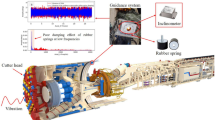Abstract
Recent advancements in computational power technology and wide-usage of high qualified electronic hardware allow many engineers to create their control strategies in data-driven and model-free approaches, such as reinforcement-learning, genetic algorithm and other machine learning topics, rather than classical and modern control approaches. In this study, Q-Learning RL algorithm combined with analytic LMI method has been utilized to solve micro-scale vibration isolation problem as energy efficient as possible.
Access this chapter
Tax calculation will be finalised at checkout
Purchases are for personal use only
Similar content being viewed by others
References
Houqe, M.E., Mizuno, T., Ishino, Y., Takasaki, M.: A three-axis vibration isolation system using modified zero-power controller with parallel mechanism technique. IEEE/ASME Trans. Mechatron. 21(6), 1055–1062 (2011)
Houqe, M.E., Mizuno, T., Ishino, Y., Takasaki, M.: A six-axis hybrid vibration isolation system using active zero-power control supported by passive weight support mechanism. J. Sound Vib. 329(17), 3417–3430 (2010)
Liu, C., Jing, X., Daley, S., Li, F.: Recent advances in micro-vibration isolation. Mech. Syst. Signal Process. 56, 55–80 (2015)
Yalcin, B.C., Erkan, K.: 3-DoF zero power micro vibration isolation via linear matrix inequalities based on Hinf and H2 control approaches. Mech. Syst. Signal Process. 153. https://doi.org/10.1016/j.ymssp.2020.107506
Shahadat, M.M.Z., Mizuno, T., Ishino, Y., Takasaki, M.: Active horizontal suspension system using negative stiffness control. In: IEEE International Conference on Control Automation and Systems, October 2010, pp. 1946–1951, Gyeonggi-do, South Korea (2010)
Zhu, T., Cazzolato, B., Robertson, W.S.P., Zander, A.: Vibration isolation using six degree-of-freedom quasi-zero stiffness magnetic levitation. J. Sound Vib. 358, 48–73 (2015)
Ahn, H.J., Hwang, K.J., Nguyen, D.C.: Eddy current damper for passive reaction force compensation of a linear motor motion stage. Proc. Inst. Mech. Eng. Part I J. Syst. Control Eng. 231(5), 360–366 (2017)
Hafner, R., Riedmiller, M.: Reinforcement learning in feedback control. Mach. Learn. 84, 137–169 (2011). https://doi.org/10.1007/s10994-011-5235-x
Huang, T., Liang, Y., Ban, X., Zhang, J., Huang, X.: The control of magnetic levitation system based on improved q-network. In: 2019 IEEE Symposium Series on Computational Intelligence (SSCI), Xiamen, China, pp. 191-197 (2019). https://doi.org/10.1109/SSCI44817.2019.9002980
Wongsa, S., Kowkasai, N.: Deep deterministic policy gradient for magnetic levitation control. In: 2020 17th International Conference on Electrical Engineering/Electronics, Computer, Telecommunications and Information Technology (ECTI-CON), Phuket, Thailand, pp. 796–799 (2020). https://doi.org/10.1109/ECTI-CON49241.2020.9158096
Erkan, K., Yalçın, B.C., Garip, M.: Three-axis gap clearance I-PD controller design based on coefficient diagram method for 4-pole hybrid electromagnet. Automatika 58(2), 147–167 (2017)
Mizuno, T., Takasaki, M., Kishita, D., Hirakawa, K.: Vibration isolation system combining zero-power magnetic suspension with springs. Control Eng. Pract. 15, 187–196 (2007)
Yalcin, B.C.: Linear matrix inequality based robust control for multi degrees of freedom hybrid electromagnetic vibration isolation. Ph.D. thesis, Yildiz Technical University, Istanbul, Turkey, October 2019
Yalçın, B.C., Fevzi Bozkurt, A., Erkan, K.: Experimental validation of linear matrix inequality based H2 full state feedback controllers on a 3-DoF 4-pole hybrid electromagnetic vibration isolation stage. In: 2019 IEEE International Conference on Mechatronics (ICM), Ilmenau, Germany, pp. 389–395 (2019). https://doi.org/10.1109/ICMECH.2019.8722873
Atlıhan, M., Yalcin, B.C., Erkan, K.: Force and torque parameter estimation for 4-pole hybrid electromagnet using ANFIS hybrid learning algorithm. Turkish J. Electr. Eng. Comput. Sci. 25, 3684–3698 (2017). https://doi.org/10.3906/elk-1605-364
Yalçın, B.C., Sever, M., Erkan, K.: Observer-based \(H_{2}\) controller design for a vibration isolation stage having hybrid electromagnets. J. Low Freq. Noise Vibr. Active Control 37, 1134–1150 (2018)
Boyd, S., El Ghaoui, L., Feron, E., Balakrishnan, V.: Linear Matrix Inequalities in System and Control Theory. SIAM Publisher, Philadelphia (1994)
Yazici, H., Sever, M.: L2 gain state derivative feedback control of uncertain vehicle suspension systems. J. Vib. Control 24(16), 3779–3794 (2018). https://doi.org/10.1177/1077546317711335
Yazici H, Sever M. Observer based optimal vibration control of a full aircraft system having active landing gears and biodynamic pilot model. Shock Vibr. 2016, Article ID 2150493. https://doi.org/10.1155/2016/2150493
Sever M, Yazici H, Disturbance observer based optimal controller design for active suspension systems. In: IFAC-PapersOnLine, 6th IFAC Symposium on System Structure and Control SSSC (2016). https://doi.org/10.1016/j.ifacol.2016.07.505
Yazici, H., Sever, M.: Active control of a non-linear landing gear system having oleo pneumatic shock absorber using robust linear quadratic regulator approach. Proc. Inst. Mech. Eng. Part G J. Aerosp. Eng. 232(13), 2397–2411 (2018). https://doi.org/10.1177/0954410017713773
Goodfellow, I., Bengio, Y., Courville, A.: Deep Learning. MIT Press (2016). http://www.deeplearningbook.org
Author information
Authors and Affiliations
Corresponding author
Editor information
Editors and Affiliations
Rights and permissions
Copyright information
© 2022 The Author(s), under exclusive license to Springer Nature Switzerland AG
About this paper
Cite this paper
Bozkurt, A.F., Yalçın, B.C., Erkan, K. (2022). Machine Learning Based \(\mathcal {H}_2\) Norm Minimization for Maglev Vibration Isolation Platform. In: Arai, K. (eds) Intelligent Systems and Applications. IntelliSys 2021. Lecture Notes in Networks and Systems, vol 294. Springer, Cham. https://doi.org/10.1007/978-3-030-82193-7_7
Download citation
DOI: https://doi.org/10.1007/978-3-030-82193-7_7
Published:
Publisher Name: Springer, Cham
Print ISBN: 978-3-030-82192-0
Online ISBN: 978-3-030-82193-7
eBook Packages: Intelligent Technologies and RoboticsIntelligent Technologies and Robotics (R0)




